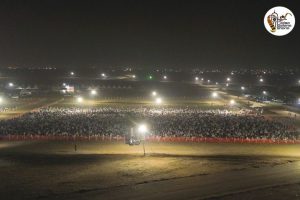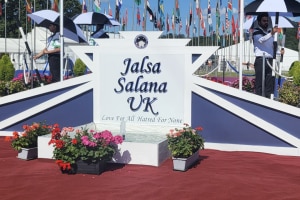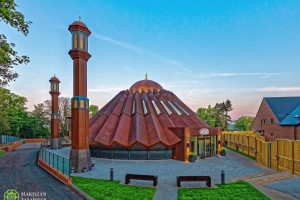
Depending on how patriotic you feel, flags carry a lot of significance today and have done so throughout history. It is recorded that founder of the Zhou dynasty in China would have white flag carried ahead of him.[1]
In battle it was a symbol of power and rallying point. So, when the flag bearer was killed, the flag would fall, signifying defeat of the army. In 54 BCE, Lucius Petrosidius, a Roman soldier assigned the duty of carrying the emblem of the Roman legion in battle was killed. The Roman Emperor Julius Caesar praised him for his bravery because before he died he threw the banner he was holding behind a wall so that the enemy could not capture it.[2]
In the first full scale battle fought in self-defense by the Muslims after years of persecution known as the Battle of Badr, the Holy Prophet Muhammad (sa) gave a white flag to Hazrat Mus’ab bin Umair (ra). There were two additional black flags, one of which was given to Hazrat Ali (ra) and was made from cloth belonging to Hazrat Aishah (ra). The other one was assigned to a Companion from the Ansar – Muslims who were native to Madinah.
A few years on from that, the Holy Prophet Muhammad (sa) sent an army of 3000 Muslims to combat the Byzantine army amassing on the Syrian border. He appointed Zaid bin Harithah (ra) as the commander of the army, and said if anything happens to Zaid, Ja’fa bin Abi Talib (ra) will be the next commander. When Zaid (ra) was killed in battle Ja’far (ra) took up the Muslim flag. In the midst of a duel his right hand was cut and so he held the flag in his left, but that too was severed shortly after. Not wishing for the flag to fall, he clutched it tightly using the remaining part of his arms to his chest. He eventually was killed, but gave his life defending the flag.[3]

‘Liwa-e-Ahmadiyyat’ – The Flag of Ahmadiyyat
The year 1939 marked the 50th anniversary for the establishment of the Ahmadiyya Muslim Community as well as 25 years of the Caliphate of the Second Head of the movement, Hazrat Mirza Bashiruddin Mahmud Ahmad (ra). Some members of Majlis-e-Shura [Consultative body of the Community comprised of members elected from their respective areas] suggested that the Community should have a flag of its own.
This divided opinion among the members, as some saw a flag as a sign of political representation of a state or country. The Second Caliph (ra) consulted with the scholars of the community and heard their opinions. Following this, he put the decision to the Shura again who voted in favour of having a flag. The Second Caliph (ra) approved the decision of the Shura and preparations began for making a flag. However, Hazrat Mirza Bashiruddin Mahmud Ahmad (ra) issued strict instructions about how it would be made. He instructed:
- Money for the flag to be collected from the companions of the Promised Messiah (as)
- The cotton should be bought from the money collected
- The cotton should be given to the female companions to spin into thread
- Companions of the Promised Messiah (as) who are tailors to prepare the cloth for the flag
- Companions should cut and trim the wood to be used for the mast
Carrying out these instructions would result in the first flag of the Community. All subsequent flags were to be copied and reproduced from this one.
Protocols for Carrying the Flag
Anyone who has been to an Annual Convention (Jalsa Salana) of the Ahmadiyya Community would have seen men standing guard around the flag of Ahmadiyyat. That is because of the set protocols issued by the Second Caliph. He said:
- The flag is to be guarded by 12 men
- It should be handed to two Nazir’s [administrative head of Sadr Anjuman Ahmadiyya] who will be responsible for its safety
- It should be kept in a secure lock, which has two keys and both keys are needed to access it
Features of the Flag

The original flag was raised aloft for the first time at the Annual Convention in Qadian (see featured image above), India, in 1939 by the Second Caliph, Hazrat Mirza Bashiruddin Mahmud Ahmad (ra). The design is simple but full of meaning. The original flag was:
- 18ft long, 9 ft wide
- Black in colour
- A crescent and star to the right side and full moon on the left
- A white minaret towards the left side of the flag
- The verse of the Quran over the full moon:
وَلَقَدۡ نَصَرَكُمُ ٱللَّهُ بِبَدۡرٍ وَأَنتُمۡ أَذِلَّةٞ
‘And Allah had already helped you at Badr when you were weak’
Each year the hoisting of the flag of Ahmadiyyat marks the opening of the Annual Convention. And raising the flag of that specific country shows that Islam Ahmadiyyat it is not something alien to that country, but an integral part of that society working for peace, love and unity. The Promised Messiah (as) said: ‘The refuge of my flag will be acquired by every blessed person’ and it is this refuge the adherents come to seek in these annual conventions.
ENDNOTES
[1] https://www.britannica.com/topic/flag-heraldry
[2] https://classics.mit.edu/Caesar/gallic.mb.txt
[3] Hazrat Mirza Bashiruddin Mahmud Ahmad, Life of Muhammad, (Tilford, UK: Islam International Publications Ltd, 2014) 150




Assalamo Alaikum wa rahmatullah. May God bless you Zafar Malik Sahab. After learning that the flag was a shura proposal which Khalifatul Masih II (RA) approved, the following question came to my mind: Who designed the flag and decided on the verse of the Qur’an? I could assume it was Huzur-e-Anwar but if someone could confirm, ideally with a source, I would be grateful. Jazakumullah Ahsan Al-Jaza